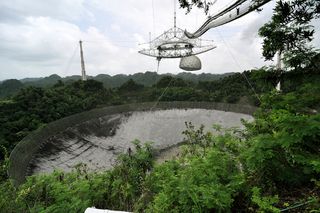Hurricane Maria Damages Parts of Puerto Rico's Arecibo Observatory
Puerto Rico's iconic Arecibo Observatory has sustained some significant damage from Hurricane Maria, officials reported today (Sept. 22).
The storm hit the island as a Category 4 hurricane Wednesday (Sept. 20) and left widespread destruction in its wake. Without power, phones or internet service, the Arecibo Observatory has been offline since the storm hit.
The Arecibo Observatory houses the world's second-largest radio telescope. While the overall structure of the telescope is still standing, it sustained some pretty serious damage from Hurricane Maria, according to an update from the Universities Space Research Organization (USRA), which helps to operate the Arecibo Observatory.
One telescope operator at Arecibo managed to contact USRA officials Thursday (Sept. 21) via a short-wave radio transmission. National Geographic's Nadia Drake reports that Pennsylvania State University professor Jim Breakall spoke with the telescope operator, who was identified as Ángel Vazquez, and said staff members and their families were safe after sheltering at the facility. Vazquez also detailed some of the damage done to the iconic telescope.

A 96-foot (29 meters) antenna that was suspended above the telescope's 1,000-foot (305 m) dish was lost as a result of the hurricane, "with falling debris puncturing the dish in several places," USRA officials said in the update. The antenna was affixed to a platform suspended about 500 feet (150 meters) above the dish, which is made out of a metal mesh. [The Arecibo Observatory: Puerto Rico's Giant Radio Telescope in Photos]
"Also, a separate 12-meter [40-foot] dish used as a phase reference for Very Long Baseline Interferometry (VLBI) was lost," the USRA update states. VLBI is a method astronomers use to make radio telescopes more powerful by creating a network of smaller telescopes that work together.
Officials have yet to conduct "a full assessment of the damage, repairs that are needed and when the observatory can resume observations," Nicholas White, senior vice president for science at the USRA, said in a statement.
Get the Space.com Newsletter
Breaking space news, the latest updates on rocket launches, skywatching events and more!
Getting to the observatory will be a challenge, though, as roads are covered in debris and are inaccessible at this time, USRA officials said.
Before the hurricane, Arecibo officials tweeted that the observatory would reopen to staff today, though it seems unlikely that anyone who didn't take shelter at the observatory will be able to report for work.
The visitor center is officially closed through Wednesday (Sept. 27), Arecibo representatives said on Twitter Monday (Sept. 18) as the observatory was preparing for the second major hurricane to hit Puerto Rico this month. Hurricane Irma also hit the island on Sept. 6, though the Arecibo Observatory made it through that storm relatively unscathed.
Email Hanneke Weitering at hweitering@space.com or follow her @hannekescience. Follow us @Spacedotcom, Facebook and Google+. Original article on Space.com.
Join our Space Forums to keep talking space on the latest missions, night sky and more! And if you have a news tip, correction or comment, let us know at: community@space.com.

Hanneke Weitering is a multimedia journalist in the Pacific Northwest reporting on the future of aviation at FutureFlight.aero and Aviation International News and was previously the Editor for Spaceflight and Astronomy news here at Space.com. As an editor with over 10 years of experience in science journalism she has previously written for Scholastic Classroom Magazines, MedPage Today and The Joint Institute for Computational Sciences at Oak Ridge National Laboratory. After studying physics at the University of Tennessee in her hometown of Knoxville, she earned her graduate degree in Science, Health and Environmental Reporting (SHERP) from New York University. Hanneke joined the Space.com team in 2016 as a staff writer and producer, covering topics including spaceflight and astronomy. She currently lives in Seattle, home of the Space Needle, with her cat and two snakes. In her spare time, Hanneke enjoys exploring the Rocky Mountains, basking in nature and looking for dark skies to gaze at the cosmos.
